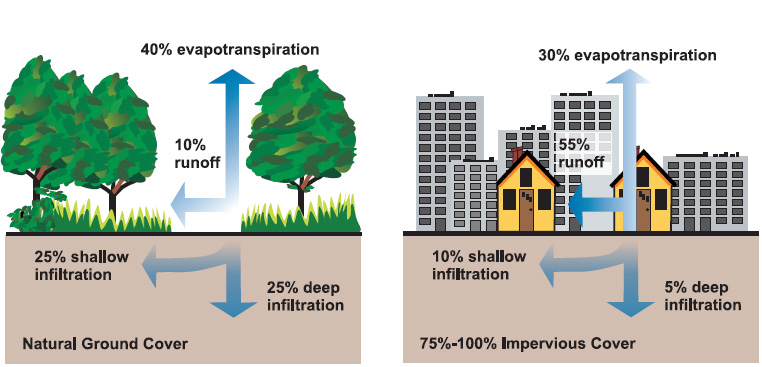This is how New Orleans is rebuilding to be more resilient
Stronger levees are not enough to protect New Orleans from extreme weather, so the city is deploying a raft of measure to live with the changing climate.
T
he neighborhood of Gentilly, New Orleans, which was badly damaged by Hurricane Katrina in 2005, has become the city’s first ‘Resilience District’.
This means that the process of rebuilding, which is still ongoing, will involve precise and direct measures to protect the area from future disasters – and provide a model for how other cities can thrive in a changing environment.
Living with danger
New Orleans government officials have come to the realisation that higher or stronger levees will not protect the city from extreme weather events. Instead, learning to live with the water and adapting properties and neighbourhoods to cope with future floods and storms has become the focus.
Hurricane Katrina was the deadliest hurricane for almost a century and damaged substantial areas of the city and its surroundings. As cities face a heating world, with climate change leading to more extreme weather events, efforts to safeguard against future similar disasters have become more urgent.
In Gentilly, New Orleans, resilience building aims include reducing flood risk through smart urban water management, drainage improvements, as well as education, health and recreation programmes.

Source: Wikipedia
Stormwater challenge
Specifically, initiatives include a water garden to store 10 millions gallons of stormwater, stormwater management built into streets and playgrounds, retrofitting existing woodlands to capture water from neighbouring areas and investment in micro-grids to increase water and energy resilience.
The ultimate goal is to protect people’s homes but, in doing so, the scheme hopes to bring greater neighbourhood benefits. Creating a local green infrastructure industry will bring jobs to a city which has a high unemployment rate. Youth groups and local artists are encouraged to create public art to enhance understanding of Living with Water. The Mirabeau Water Garden will be a place of recreation and environmental learning.
Residents are incentivised to install and manage flood management systems on their own properties, with 140 homeowners benefitting from up to $25,000 in stormwater infrastructure.
Other strategies for increasing the resilience of urban areas include permeable paving, rain barrels and dry creeks, which can hold large amounts of flood water and reduce stormwater runoff. Planting trees can reduce flood risk. Bioretention cells, bioswales and infiltration trenches are all bowl-like channels which are designed to capture and store storm runoff.
Rebuild by Design
Rebuild by Design began as a design competition set up in response to the devastating impact of Hurricane Sandy on the East Coast of America in 2012. It was set up by the U.S. Department of Housing and Urban Development (HUD) to raise the bar for response, preparedness, and resilience.
With a focus on collaboration, it works with cities to figure out how to make neighbourhoods more resilient and protect against natural disasters.
In Athens, Greece, for example, Rebuild by Design is working alongside academics from various institutions to enhance the environmental capacity of Lycabettus Hill, a large public green space that looks over the historical city. The site will be enhanced to provide urban heat mitigation and stormwater runoff.

Local woods are busy absorbing more water. Photo by Infrogmation
In Atlanta, USA, a 1.4 mile roadway that cuts through Downtown Atlanta, is being turned from a transportation corridor into a greener gateway, with cycle paths, better walking infrastructure, trees and nature and therefore urban heat and rainwater runoff mitigation.
Rebuild is working with the City of Boston on its Climate Ready Boston plan. Preparing for climate change will include protecting the Downtown area from coastal flooding and raising areas, such as parks and pathways, as sea levels rise.
Value for money
New York State has been severely affected by extreme weather over the last 10 years, with every county affected, costing $37.3billion in federal aid for recovery efforts. By 2050, scientists estimate that the costs of climate change in New York State will rise to $10billion per year.
Suggested resilience options for New York State to help the area prepare for climate change include daylighting rivers, which means removing obstructions, covers, or bringing a previously open-air river above ground. This allows for greater river runoff and enhances the river’s capacity to provide a habitat for species as well as aesthetics. Ninety per cent of New York State’s population live by the water.
Adapting the world’s cities to protect people from climate change will save money in the long run. A report by the National Institute of Building Sciences in 2018 found that for every dollar invested in natural disaster mitigation, six would be saved in future protection. And, of course, crucially, disaster mitigation projects will save lives and people’s homes.
The ideas presented in this article aim to inspire adaptation action – they are the views of the author and do not necessarily reflect those of the Global Center on Adaptation.